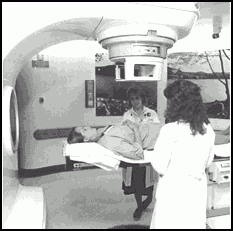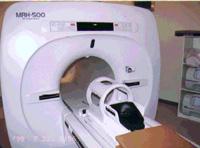MRI's, X-Rays, and Other Positive Uses of Radioactivity!
Has anyone in your family ever gone to a doctor or hospital for an X-ray, CAT scan, or MRI?
Have you?
Then you know that even if the equipment looks scary, it doesn't hurt you! And you may also know how important such equipment can be for helping scientists and doctors determine what is causing various health problems!
Scientists use special equipment like microscopes, MRIs (Magnetic Resonance Imaging), CAT scans (Computerized Axial Tomography), and X-rays to help them see things they can't see with the "naked eye." MRI's, CAT scans, and X-rays can look inside our bodies to help determine what may be wrong when we are sick.
Here's what an MRI looks like!
The technology developed from the early discovery of uranium, the process of fission, and nuclear weapons, has also provided us with many lifesaving diagnostic tools in the field of Nuclear Medicine! These medical tools, and radioactive materials are essential elements in medical research, cures for cancer, and the safety of industrial processes.
There are many beneficial uses of radiation and radioactivity—for example, radiation is frequently used for cancer treatments, where tumors are exposed to high levels of radiation in a controlled setting. Using radiation alone or in addition to chemotherapy, persons with leukemia, lung cancer, cervical cancer, bone cancer, Hodgkin's Disease, and thyroid cancers have been cured.
In addition radioactive materials such as tritium, carbon-14, sulfur-35, phosphorus-32 and others produced in nuclear reactors are used to label cells, proteins, and various chemicals. These labeled chemicals have allowed us to unlock the mysteries of the human brain, diagnose disease, and study the human body (both it's genetics and physiology)!
However, when not handled properly or when proper safety procedures are not followed, radioactive materials can cause harm to our bodies and possibly could cause cancer.
Radiation Exposures and Safety Precautions:
Early uranium miners were exposed to elevated levels of radon gas and thus the decay products of radon. These miners showed an increased risk of lung cancer. So with that knowledge in hand, modern mines have increased ventilation rates to prevent this type of exposure.
Radium present in the mill tailings of the uranium extraction process and used to paint glow-in-the-dark watch and clock dials, was not disposed of properly in some areas in the past. This improper handling of radium caused many cases of cancer in watch-dial painters who licked the brushes and ingested the radium in the paint. Improper disposal of the waste from these industries also contaminated homes, parks, and buildings across the United States. With those concerns in mind, steps have been taken to inform the public of such risks and reduce the possibility of such exposures.





